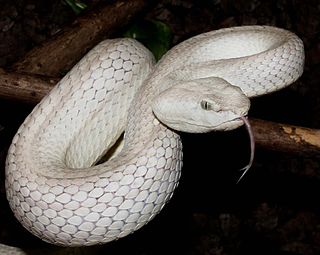The yellow-spotted salamander is a species of salamander in the family Hynobiidae, endemic to China, where it is known from Nanchuan in Chongqing, Suiyang in Guizhou, Lichuan in Hubei, and Sangzhi in Hunan Province. However, genetic methods have revealed cryptic species within the Liua–Pseudohynobius complex, and the actual distribution of the yellow-spotted salamander is turning out to be different. Only animals from Lichuan in Hubei and Sangzhi have been positively identified as being yellow-spotted salamanders, whereas animals collected from Nanchuan were described as a new species, P. jinfo, by Wei et al. in 2009.

Leptopelis flavomaculatus is a species of frog in the family Arthroleptidae. It is found in the lowlands eastern and southern Africa, from Mozambique north of the Save River and Zimbabwe to Malawi, eastern Tanzania, and coastal Kenya. Its common names are yellow-spotted tree frog, brown-backed tree frog, brown forest treefrog, and Johnston's treefrog.

Lynchius flavomaculatus, also known as the yellow-spotted Andes frog, is a species of frog in the family Strabomantidae. It is found in the Andes of southern Ecuador and northern Peru.

Trimeresurus flavomaculatus is a venomous pit viper species endemic to the Philippines. Two subspecies are currently recognized, including the nominate subspecies described here.

Mugilogobius is a genus of fish in the family Gobiidae. They are found in fresh, brackish and marine water of the Indo-Pacific region. Several of the freshwater species have highly restricted distributions.
Zaireichthys is a genus of loach catfishes of the family Amphiliidae.
Trimeresurus flavomaculatus halieus is a venomous pitviper subspecies endemic to the Philippines.

Trimeresurus mcgregori, commonly known as McGregor's pit viper or the Batanes pit viper, is a species of venomous snake in the subfamily Crotalinae of the family Viperidae. The species is endemic to the Philippines.

The dahong palay, literally "rice leaf" in Tagalog, is a single-edged sword from the southern Tagalog provinces of the Philippines. It was originally used by farmers to clear thick grass growth. However, during the Philippine revolution of 1896, farmers from Batangas soon came to favor it for its "slashing and thrusting" feel.
Zaireichthys camerunensis is a species of loach catfish found in Cameroon and Guinea in the Niger River basin. It reaches a length of 3.3 cm. The humeral process of the pectoral girdle is short and without denticulations. The neural and hemal spines tend to be simple and slender.
Zaireichthys dorae, the Chobe sand catlet, is a species of loach catfish endemic to Angola where it is only found in the Rio Luachimo. It reaches a length of 2.7 cm. The humeral process of the pectoral girdle is moderately long with poorly developed or fine denticulations. The neural and hemal spines tend to be simple and slender. This species occurs over sand and is usually buried with just the eyes protruding.
Zaireichthys mandevillei is a species of loach catfish found in the Central African Republic and the Democratic Republic of the Congo where it is found in the Congo River Basin. It grows to a length of 2.6 cm and has a broad, black collar just behind the head and a spotted colour pattern. The barbels are attenuate, with the maxillary barbels extending posteriorly to middle to end of the pectoral fin spine and the caudal peduncle is slender. The humeral process of the pectoral girdle is short and without denticulations. The caudal fin is deeply forked, with the upper lobe much shorter and smaller than the lower lobe; also, the fin rays in lower lobe noticeable thicker than those in upper lobe.
Zaireichthys rotundiceps, the Spotted sand catlet, is a species of loach catfish that occurs in the countries of Botswana, Kenya, Malawi, Mozambique, Namibia, Tanzania, Zambia and Zimbabwe with uncertain records from Burundi and the Democratic Republic of the Congo. This species may actually consist of several species. It reaches a length of 3.8 cm. The colouration of Z. rotundiceps is highly variable, from abundant dark spots in several rows to a light pale spotting pattern; marks are often present on the head and fins as well as the body. The humeral process of the pectoral girdle is moderately long with poorly developed or fine denticulations. The caudal fin shape is variable, from slightly forked through, emarginate, truncate, or even slightly rounded, but not deeply forked. The dorsal and pectoral fins have strong and stout spines. It inhabits fairly shallow water where it occur over sand, usually buried with just the eyes protruding. Its eggs are few (12–16) and large, which suggests that the parents may care for the eggs and young.
Zaireichthys wamiensis is a species of loach catfish endemic to Tanzania. It grows to a length of 2.5 cm (0.98 in) SL. Its natural habitat is rivers.|
Zaireichthys zonatus is a species of loach catfish endemic to the Democratic Republic of the Congo where it is found in the rapids just below Pool Malebo. It grows to a length of 2.5 cm. Its body has vertical bands with darkened margins. The humeral process of the pectoral girdle is short and with a few fine denticulations at its tips. The dorsal and pectoral fins have strong and stout spines. Z. zonatus is found only at the edges of a sandy areas, although their habitat is very rocky.

Smerinthulus perversa, the lichenous hawkmoth, is a species of moth of the family Sphingidae. It is known from Taiwan, Nepal, north-eastern India, northern Myanmar, south-western and southern China and Thailand.
Anthene flavomaculatus, the yellow-spot ciliate blue, is a butterfly in the family Lycaenidae. It is found in Nigeria, Cameroon and northern Angola. The habitat consist of forests.

Lynchius is a genus of frogs in the family Strabomantidae. The name honours herpetologist John D. Lynch. The distribution of Lynchius is restricted to the Cordillera Oriental in southern Ecuador and Cordillera de Huancabamba in northern Peru.
Stenocoptus flavomaculatus is a species of beetle in the family Cerambycidae. It was described by Breuning in 1970.
Yellow-spotted tree frog is a common name for several frogs and may refer to:







